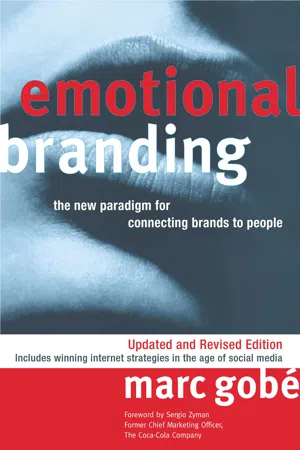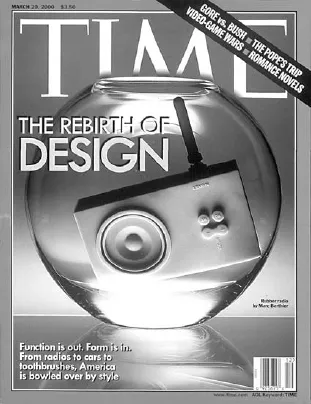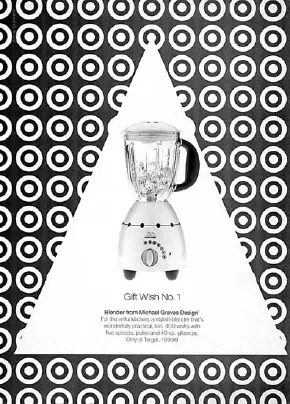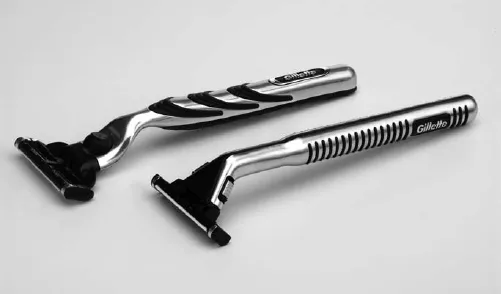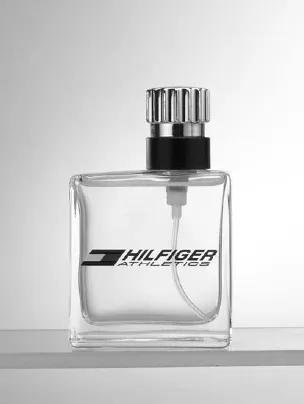![]()
section III:
imagination
innovation is a brand’s
best friend!
![]()
INTRODUCTION
Thinking Outside of the Box
After looking into the fascinating shifts taking place in the current demographic landscape and delving into the untapped realm of the senses, we are more fully prepared to immerse ourselves in the dynamic world of Emotional Branding. The following chapters are the true backbone of this book because they explore the real everyday challenges of bringing a brand to life as a multidimensional, emotionalized entity that people will fall in love with and continue to love.
Convincing people to buy a product or service in a very saturated, competitive environment is obviously fraught with difficulty. The key to success is to begin to understand the formidable and undefined emotional power that ultimately sways everybody’s decision-making. As with all worthwhile endeavors, there are no pat answers about the best way to do this. Creativity just doesn’t work that way! It demands an ongoing commitment to building an open-ended, relationship-oriented culture that encourages emotional sensitivity and understanding and the questioning of the status quo, which, in turn, will inevitably lead to the most thrilling expressions of creativity.
The kind of inspiration that leads to innovative brand-design programs in product development, packaging, retail, brand presence, and advertising cannot simply be bottled or bought—but it can be sought . . . and eventually sold!
![]()
10
Sensory Design: The New Branding Power Tool
People need an escape and an experience that is different from their day-to-day lives. I often use that analogy with our car designers: we’re not creating great automobiles, we’re trying to create great experiences.
—J Mays, creator of the Volkswagen Beetle, interviewed by Jim Blair for Artbyte
What if manufacturers and retailers took this statement by Mays seriously in terms of viewing their products and store environments as, above all, creation of an intense and wonderful experience? Imagine what could be done if corporations had this kind of commitment to design from the standpoint of creating an emotional relationship with consumers. As we progress toward an economy that thrives on personal relationship, the value of designing consumer products and retail environments as sensory experiences will require, more than ever before, emotion, imagination, and vision.
From Function to Feel: Welcome to the Twenty-first Sensory!
I believe that design is the most potent expression of a brand and that ultimately bringing powerful ideas to life through design is the best way to create a lasting link between a manufacturer or retailer and the consumer. The Volkswagen Beetle, the Gillette series, Issey Miyake’s couture, and the Sephora and Godiva stores are among a long list of examples of product or retail designs that work. They are proof that at the end of the day, design creates emotions, sensory experiences, and, ultimately, sales.
I always believed that design would eventually belong to the twenty-first century—the emotional age—and this prediction is now starting to become reality. Time magazine’s March 20, 2000, cover hailed the “Rebirth of Design” a little over fifty years after Raymond Loewy, the much-celebrated French-born designer of his generation, made the cover. Such a mass-media tribute to a designer was unprecedented at the time and signaled design’s golden age in the ’50s. Time magazine now tells us that, once again, “Function is out. Form is in. From radios to cars to toothbrushes, America is bowled over by style.” The New York Times responded to this trend with a full issue of the spring 2000 edition of the New York Times Magazine devoted to home design with “Larger than Life” designer George Hansen, inventor of the swing-arm wall lamp, on the cover. We have seen major, important design exhibits such as the Triennial Design Retrospective at the Cooper Hewitt Museum in New York. Catherine McDermott, the famed author and consultant curator at the London Design Museum, has published a book called 20th Century Design, which presents “a collection of the most important and influential pieces of design produced in the modern age.”110
Today’s broad media coverage of design has elevated the status and recognition of designers—such as Philippe Starck, the French “enfant terrible” of furnishing design; J Mays, the mastermind behind the Volkswagen Beetle; Jonathan Ives, the genius behind Apple; and Tom Ford, the multifaceted Renaissance designer for Gucci—to the heights of stardom in both the business world and with the general public in a way never seen before. Companies like GM are hiring star European designers like Anne Asenisio, who helped transform Renault into one of the top automotive brands in the industry.
It is encouraging to see that design is once again taking the driver’s seat in defining the aesthetic of products that we buy on a mass level. Loewy, whose product designs became some of the most successful marketing tools of his time, and who once said “There is no curve as beautiful as a rising sales graph,” would be proud of this crop of new designers with their finger so firmly on the pulse of the emotional and practical needs of consumers in a new economy. These are primarily needs for individualistic expression within the confines of a budget—the need for objects to have an approachable, humanistic feel in a cold, high-tech world . . . These needs are being answered with finesse and a ferocious creativity.
These are primarily needs for individualistic expression within the confines of a budget; the need for objects to have an approachable, humanistic feel in a cold, high-tech world. . .
But what happened from the ’50s until the beginning of this century? There was a gap of time between the ’60s and ’90s when design faded quietly into the background and a bland industrial production controlled the aesthetics of mass products. What prompted this return to the popularity of design after such a long crossing of the desert for designers? What exactly are the changes in the world and in our economies that have encouraged such a renewed focus on design? These are interesting questions to ponder because they tell us a great deal about the Emotional Economy and why consumers desire great design today.
Obviously, design was not dead during this gap, but it did not have the same impact and visibility as it has today. So what is it about the atmosphere of both the ’50s and today that fosters a love of design? For starters, there is great similarity between the ’50s, a period of booming economy following World War II, and the beginning of this century, which is witnessing the longest prosperity period in the history of this country. Today’s new economy, fueled by the advent of breakthrough ideas inspired by technology as a new business model, is not at all dissimilar from half a century ago, when the industrial economy and the advent of consumerism had an incredible impact on the prosperity people enjoyed. Good economies encourage growth through imagination, risk, and rewards in business. Good economies, of course, thrive on people’s seeking a better standard of living. The difference is that the ’50s offered people the opportunity to get better jobs, and the possibility of acquiring new homes, new cars, and new appliances did not even exist before, whereas in the twenty-first century, the accumulation of goods is not as critical as the need to reach out for a better quality of life. Yes, we are spoiled today . . . but that is not the only reason we are becoming so choosy about the way things look. Overall, this shift represents an evolution from the material to the spiritual.
Veronique Vienne, author of The Art of Doing Nothing, a book I will talk more about later, and one of the most respected journalists writing articles on design, told me that she felt that this design explosion can be attributed to “the nostalgia for times when things happened more slowly, and [to] our quest for the art of living a quality life.”111 In this new world where speed and computer screens are moving our life more and more out of touch with physical reality, the direct experience we have with the products we interact with on a daily basis can impact our moods and our feelings in the most profound way. The products in our immediate proximity, whether they include a portable phone, a palm anything, or the most banal objects from a dish scrubber down to the garbage can, need to bring with them a new sense of reassurance and pleasure. In an out-of-control world, it is the most human instinct of all to want to be able to impact our immediate surroundings with things of beauty and originality. This gives us a new sense of control. “People need to be engaged emotionally, and design is proof of the presence of the human dimension,” explains Vienne. Finding an element of personal human touch reconnects us to what’s real.
A truly talented designer can tap into our universal need for permanence and beauty. As we are leaving the old economy, its cold industrial ugliness might be leaving us . . . replaced by the warmth and beauty associated with a new art of living. Designers seem to have understood this emotional expectation from people
THE RETRO-CHIC STYLE
By taking inspiration for their designs from previous decades, designers have foreseen our craving to anchor ourselves with known cultural values that are adapted to our time. The iMac computer looks like a TV set from the ’50s, and the latest Jaguar aesthetics as well as the new Volkswagen Beetle design are a modern interpretation of past models. Philippe Starck recently redesigned Emeco’s famous lightweight brushed-steel Navy chair from the ’40s in another attempt to bring continuity to new generations by translating for today’s tastes design successes of the past. Michael Graves’s designs for Target take their inspiration from the Memphis postmodern design movement he helped create, and the list, quite literally, goes on and on!
A truly talented designer can tap into our universal need for permanence and beauty.
The main thing these designs have in common is that they are created to become irresistible, pleasurable sensory experiences that have both meaning and attractiveness. Design today has transcended the element of functionality so prevalent in the industrial economy to “embrace psychology and emotion,” as Susan Yelavitch, the assistant director of the Cooper Hewitt National Design Museum, says.112 Bulthaup, the home design systems company, expresses this idea well in its advertising copy: “When you furnish your home with Bulthaup, you have arrived in your own conscious and sensitive world of design,” a statement that design is a state of mind, which invites the consumer to enter into that state of mind.
And consumers are entering . . . in droves! Design’s past elitist association with high pricing and exclusivity has evolved to extend its definition of the profession to also be about design solutions for everyone. The professional designer has been taking a more expansive and democratic route. Many design firms have recruited anthropologists and psychologists to help create designs that are people-friendly, and mass outlets have used well-known designers to create and promote their brands. Target stores’ former VP Ron Johnson, who masterminded the Michael Graves’s line of products that has had a double-digit sales growth since it was introduced last year, said that “Customers really respond to products that involve new thinking and connect with their souls.”113 In the past, this comment may have surprised a lot of manufacturers who did not even consider until now that the mass market had a soul to start with! Design is all about personalization and customization. Because well-designed products have real personality, it helps us identify a real person behind what we buy, and puts some aspect of our lives into a slower motion in a faster and faster moving world. We can mentally imagine how long it takes a creator and a craftsman to offer us their artistic vision of the environment we live in, and we can appreciate the time and care it takes to render the most innovative and exquisite products. Design can deliver on the promise of emotional and sensory experiences. It takes the edge off of standardization and mass production, destroying the robotic concepts of homogeneity and bulk to bring a new sense of humanity to our lives. The eternal question of whether design is about art or commerce is clearly answered by today’s designers. It is about people and our role in making people’s lives more fulfilling though beauty. The title in French for Loewy’s book, Never Leave Well Enough Alone, is La Laideur Se Vend Mal, or “ugliness does not sell,” a much more appropriate title for today’s business atmosphere!
The Gillette Sensor, the father of the Mach III and the brainchild of Gillette’s Phyl Symons and Peter Hoffman, is a case in point for the powerful role design can play in business. What makes this packaging great is not that the shaving system, the handle, and the blades look pretty, but that the shaver’s handle sends a strong message of the best technology any man or woman can get in the world of shaving. Blades are small and unconvincing unless their efficiency is explained to you in detail. Visuals communicate better than words, and in the case of the Gillette razor, the handle is the messenger for the blade. But it is the packaging here that really sets the stage—a most glorified stage—for this innovative product. After all, the blades can only speak for themselves when you shave! It is no wonder that they are now clearly the worldwide leaders in the shaving category.
But there are still so many brands today that are missing out on this opportunity because they do not yet understand the difference design can make in their business and have yet to consider the meaning and power of design as a strategic tool. Most talented designers are also challenging, and sometimes companies become frustrated by what they think is a designer’s lack of pragmatism when, in fact, it is mostly a commitment to fresh, unusual solutions. I will never forget the conclusion of the production department of Gillette when we presented our design for the Gillette Series, the grooming line that was launched following the success of the Sensor razor. It was a completely new way to package grooming products in this category. When we proposed very innovative designs with special finishes giving the effect of silver to build a feeling of freshness and technology in line with the core image of the Gillette brand, we were told point-blank by their production department that it could not be done. During an intense silence, I watched the look of disillusionment sweep over the faces of my team, and I realized not only their disappointment but also their conviction that it would work! Knowing for myself as well that only bold thinking could make this project a success, I replied, “Well, if you can’t do this, you can’t be a leader in your industry, challenge yourself.” A bold and gutsy statement that certainly could have gotten us fired on the spot! However, fortunately for us, in the room that day there were two great marketers who supported my assumption. And Gillette, a company that considers design the lifeblood of its business, found a way to help us do this project on time, on budget, and with the silver design we recommended.
On the other hand, an example of a missed opportunity for both us and a client was a fragrance bottle design we did for Procter & Gamble, which recommended an off-centered opening. To our dismay, this design was turned down by the company for technical reasons. Later, we saw the very same concept successfully implemented by Estée Lauder for Tommy Hilfiger’s Tommy Sport . . . guess who is one of the leaders in beauty products today?
We are now on the verge of a renewed partnership between corporations and designers. Corporations need innovative designs along with a strong understanding of trends in the marketplace to compete and reach a blasé consumer. This is something that connected designers can provide. The smart companies have already understood that “trend-focused designers” can offer so much more than just “design!” These are the companies that will succeed in the twenty-first c...
